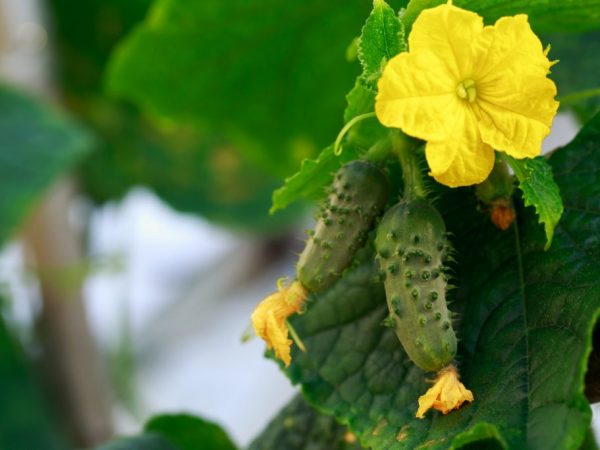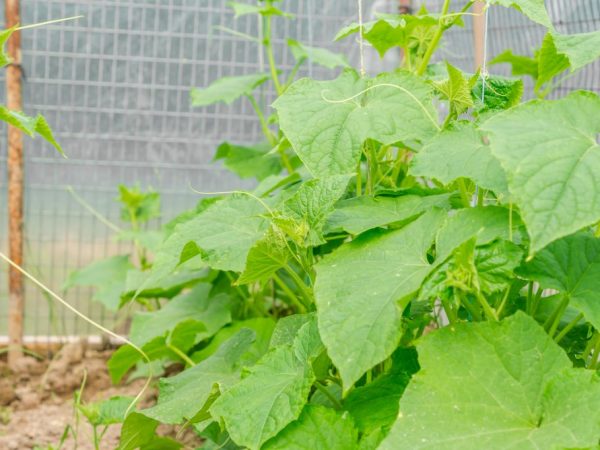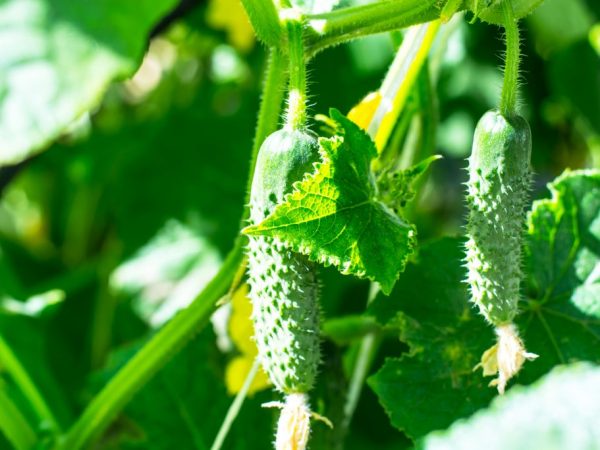How to feed cucumber bushes for good growth
How to feed cucumbers if the stems and leaves grow poorly. What fertilizers will provide high-quality crop growth throughout the season. We will consider this issue in detail in the article.

Top dressing for cucumbers for good growth
Causes of poor growth of cucumbers
Often gardeners are faced with the fact that plants grow poorly. This can happen at different stages of development. To take appropriate action, you need to determine the reasons. There may be several of them:
- violations of the water regime;
- sharp fluctuations in temperature;
- insufficient amount of nutrients.
Solution to the problem
The first two are easy to handle. It is enough to change the irrigation regime, and when the temperature drops, use a covering material (agrofibre, film).
With a lack of trace elements, cucumbers not only stop growing, but yellowing or pallor of the leaves is also observed, additional feeding is required. By the appearance of the leaves and the outlines of pigmentation, you can understand what exactly is missing:
- Lack of nitrogen - leaves become pale green over the entire surface.
- Lack of potassium - yellow border along the edge of the leaf.
- Lack of phosphorus - rusty yellow leaf edges and dry spots.
To prevent the lack of nutrients and for the growth of cucumbers, it is enough to carry out four stages of fertilization:
- two weeks after germination;
- at the beginning of flowering;
- at the beginning of fruiting;
- during fruiting.
To replenish the stock of trace elements, different types of fertilizers are used. These can be mineral or organic substances. And also in such a situation, they often resort to various folk methods.
Mineral fertilizers
Urea and superphosphate are used to fertilize cucumbers. In different periods of the growing season, they are brought in in a different combination and with a different dosage.
First feeding
For the first feeding, a solution is prepared, 1 tbsp is dissolved in 10 liters of water. l of carbamide (urea) and 60 g of superphosphate. Cucumbers are watered with this solution. when the ground is wet.
But you can also add 5 g of dry ammophos under a bush, embedded in the ground.
Second feeding

Before flowering, you need to fertilize cucumbers with potassium.
The second feeding is carried out before flowering. And it should be predominantly potash. Mix potassium, ammonium nitrate and superphosphate in a ratio of 2: 3: 4. Spread the mixture over the wet soil between the rows and close up by loosening. Such a mineral mixture is sufficient for 10 g per bush.
Cucumbers also respond well to spraying. At this stage of plant development, foliar fertilization with superphosphate can be carried out. 35 g of superphosphate are added to 10 l of water. Spray the plants in the afternoon.
These dressings will stimulate growth and vigorous flowering.
Third feeding
The third feeding is carried out when the first fruits appear. Cucumbers require additional nitrogen at this moment so that the fruits and the plant itself grow.The bushes are sprayed with a 0.1% urea solution (10 g of urea is added to 10 liters of water).
Fourth feeding
The fourth is carried out 15 days after the previous one. For this, a 0.1% urea solution is also used for spraying. This will extend the fruiting period and prevent early yellowing of the cucumbers.
It must be remembered that for fertile soil, the amount of fertilizer should be reduced to two. It is important to maintain the dosage and not get too carried away with mineral fertilizers. Exceeding the norm is also bad for the growth of cucumbers.
Organic fertilizers
If the gardener does not want to use chemical fertilizers, the question arises of how to safely feed young cucumbers for good growth.
A good option in this case would be to use organic fertilizers. Namely, different types of manure, bird droppings and herbal infusion.
First feeding
For the first feeding, you can use slurry. Manure is rich in nutrients, and in liquid form feeds bushes faster. And the chances of an overdose with such fertilizer are less.
In 10 liters of water, dissolve 500 g of cow or 200 g of horse manure. Leave to ferment for 3-4 days. Before use, dilute 1 glass of slurry in a bucket of water and water the plants. The garden bed should be well spilled with water before this.
And also for fertilization at the beginning of the growing season, you can use poultry droppings. It is rich in nitrogen, potassium and phosphorus. Which will stimulate the growth of cucumbers.
Poultry droppings are prepared for live. Add 1 liter of manure to a bucket of water. After 4-5 days, fertilization is ready. 100 ml of livestock is diluted in 10 liters of water. Pour the bushes carefully so that the solution does not get on the leaves and stems. One glass of solution will be enough for one plant.
Fertilizers from manure and droppings are used only at the beginning of crop growth. This one feeding will be enough to stimulate the bushes.
Subsequent feeding
The gardeners are advised to carry out the next three dressings with herbal infusion. It will not be difficult to prepare such fertilizers. Any herb that grows in the garden is suitable for tincture. It can be weeds, lawn grass, nettles. And the addition of medicinal herbs such as chamomile, calendula, St. John's wort will enhance the positive effect of fertilizer.

Herbal tincture will increase yields
To prepare the infusion, it is better to use a plastic container (bucket, barrel). The herbs are put into a clean container and filled with water. Keeping the proportion of 1 kg of herbs per 10 liters of water. This infusion should ferment well, and this will take about 1 week.
Bushes are poured with ready-made fertilizers under the root, but spraying on the leaf gives the best effect.
This fertilizer has a mild effect. Does not cause oversaturation with microelements. Herbal tincture is an environmentally friendly fertilizer and will not harm the garden. But it will have a good effect on the growth and fruiting of cucumbers.
Folk dressing recipes
For many years of growing cucumbers, summer residents have found other ways of feeding with natural substances. Simple and accessible to everyone substances are widely used:
- ash;
- onion peel;
- yeast.
Compared to industrial fertilizers, they are cheap and easy to use. These types of feeding have established themselves as safe and effective fertilizers so that cucumbers grow well and get sick less.
Cucumbers tend to accumulate nitrates in themselves when they are oversaturated with fertilizers. And folk dressings allow you not to worry about this, since it is difficult to overfeed the plants with them.
Ash
Probably one of the most popular fertilizers in amateur gardening. Ash is rich in potassium and phosphorus, and the amount of nitrogen is small. It is able to improve growth, flowering and fruiting without oversaturation of soil and plants with nitrogen. The presence of phosphorus helps plants to better absorb nutrients and transport water through the vascular system of the plant.
- You can fertilize cucumbers with ash in two ways, using dry ash for backing and an ash solution for irrigation.
- Fertilize cucumbers, pouring ash under each separate bush 2 tablespoons, and watering well.
- And you can also make a solution: Add a glass of ash to 1 liter of water. One glass of such a solution is enough for one plant.
- You can feed ash cucumbers every two weeks.
Yeast
Yeast is often used to grow cucumbers. The yeast contains macronutrients, which are very scarce in the soil. Yeast is rich in amino acids, proteins, B vitamins, as well as thiamine, cytokenin. They accelerate the growth of the plant itself and have a beneficial effect on the development of the root system. In studies, improvements in root formation have been recorded by a factor of 10. And with a well-developed root, all processes are more intensive and better.
For a yeast mixture you will need:
- 100 g live yeast;
- 150 g sugar;
- 3 liters of water.
All ingredients are mixed and placed in a warm place to ferment. Stir from time to time. After 3 days, the mixture is ready for use. A glass of yeast mixture is added to a bucket of water. Water the bushes, with the calculation of ½ l per bush. You can also strain the mixture and spray the plants. Feeding with yeast is carried out 3 times per season.
Onion peel
So that the cucumbers grow well, onion peels are used as a top dressing in the form of a decoction. They can both water and spray the bushes. This method works well if yellowing of the leaves is observed, and the bushes are lagging behind in development. A decoction of onion peels is also capable of prolonging the fruiting of cucumbers.
These abilities of the husk are associated with the presence of a large amount of carotene in it. Carotene stimulates growth and is also a powerful antioxidant that prevents plants from aging prematurely.
Prepare the broth by pouring 2 tbsp of husk with 2 liters of boiling water. Insist for two days. The resulting infusion is filtered and diluted with clean water. Add 1 tbsp of broth to 10 liters of water. The solution is sprayed on the bushes or watered at the root. So you can fertilize cucumbers 2-4 times per season.
A decoction of onion husks will not only stimulate the growth of cucumbers, but also prevent infestations by various pests.
Conclusions.
Stimulating the growth of cucumbers is not difficult. A wide selection of fertilizers will allow you to choose the right one, and the correct dosage and combination of nutrients will give an immediate result.


